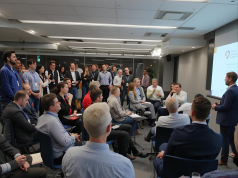The American workforce is grappling with a paradox. On one hand, a staggering 71% of US firms report a persistent struggle to find skilled workers, creating a seemingly insurmountable talent gap. On the other, millions of dedicated, experienced, and highly motivated individuals are eager to fill these very roles, yet remain stubbornly overlooked. This isn’t a problem of willingness, but a profound disconnect: a vast, unseen workforce in rural America, primarily comprised of midcareer professionals, is ready to reskill for the digital age, while employers remain deaf to their potential.
A recent study by Generation and YouGov, highlighted this week, paints a compelling picture of this missed opportunity. The data reveals that a remarkable 75% of rural midcareer professionals aged 45 and above are not just open to, but actively willing to retrain for remote jobs in high-demand fields. We’re talking about essential roles in IT support, data analytics, finance, and marketing – precisely the areas where companies are crying out for talent. This isn’t merely a niche demographic; it’s a massive, untapped reservoir of human capital, eager to contribute and close the very skills gaps plaguing corporate America.
The Reality of Rural Life: Remote Work as a Lifeline, Not a Luxury
For these rural midcareer workers, the prospect of remote work isn’t a trendy perk; it’s an economic lifeline. The challenges they face are stark and deeply rooted in their geographic realities. Financial precarity is a grim constant, with the Generation and YouGov study revealing that a disheartening 60% of rural workers cannot cover a mere $1,000 emergency. This fragility is exacerbated by dwindling local job opportunities in many rural areas, leaving limited avenues for career growth or even basic stability.
Furthermore, mobility is often not an option. The cost of relocating to urban centers, combined with deep family ties and community roots, makes uprooting their lives practically impossible. For this segment of the workforce, a truly flexible, remote position isn’t just about convenience; it’s the only viable path to accessing better-paying, future-proof jobs without abandoning their homes and support networks. It’s the bridge from economic vulnerability to opportunity.
The Ageism Barrier: A Blind Spot Costing Companies Talent
Despite their evident eagerness and the critical need for skilled workers, this valuable cohort faces a formidable, often unspoken, barrier: ageism. The same Generation and YouGov survey found that an alarming 61% of unemployed rural workers over 45 cite age as the primary reason they believe they can’t find work. This pervasive bias is a profound indictment of current hiring practices.
The perception that older workers are less tech-savvy, less adaptable, or simply “too set in their ways” is not just unfounded, it’s actively harmful. The data unequivocally proves their high willingness to reskill. What’s often overlooked is the immense value these midcareer professionals bring: decades of accumulated professional experience, strong work ethic, proven reliability, deep problem-solving skills honed over diverse careers, and a maturity that younger entrants may still be developing. By allowing outdated stereotypes to dictate hiring decisions, US companies are not only perpetuating injustice but also actively undermining their own talent acquisition efforts. They are choosing to perpetuate a talent shortage by ignoring a capable, motivated segment of the population.
The Employer’s Missed Opportunity: Focus on Pipelines, Not Just Ponds
So, why are so many US companies failing to leverage this eager talent pool? Part of the problem lies in systemic biases and ingrained hiring patterns. Many recruiters and hiring managers are accustomed to fishing in the same familiar ponds – urban centers, elite universities, or direct competitors. They might be overly reliant on algorithms that inadvertently screen out candidates based on resume gaps or non-traditional career paths, or simply overlooking applications that don’t fit a narrow, age-biased mold.
There’s a critical strategic blind spot at play. While companies agonize over “the war for talent” in overheated tech hubs, a vast, loyal, and motivated workforce in America’s heartland is waiting, ready to be trained. This isn’t about charity; it’s about smart business. Tapping into this cohort offers a way to diversify talent pools, potentially reduce recruitment costs (as these workers are often seeking stability and opportunity, not just the highest salary in a bidding war), and foster a more resilient, geographically dispersed workforce.
Solutions: Building Bridges to the Unseen Workforce
Closing this gaping disconnect requires a concerted effort from both policymakers and corporations. The future of work in the US, and the economic vitality of its rural communities, depends on it.
- Accessible, Affordable, and Targeted Training: Governments and the private sector must significantly invest in practical, flexible, and affordable online retraining programs. These initiatives should be directly linked to remote job placements in high-demand fields. Think partnerships between community colleges, tech bootcamps, and corporate employers to create clear pathways. Funding mechanisms like grants or tuition assistance specifically for midcareer reskilling in rural areas could be transformative.
- Skills-First Hiring Must Become Standard Practice: Employers need to move beyond outdated credentialism and embrace truly skills-based hiring. This means de-emphasizing age, traditional degrees, or specific industry experience, and instead focusing on assessing a candidate’s actual capabilities, potential for learning, and demonstrated soft skills. Blind resume reviews, well-designed skills assessments, and internal mobility programs can help mitigate unconscious bias.
- Strategic Remote Work Adoption: Remote work should be viewed not merely as a flexibility perk, but as a critical strategic tool for talent acquisition and retention. Companies need to design truly remote-first roles and build the infrastructure to support geographically dispersed teams effectively. This allows them to tap into talent pools previously inaccessible, particularly in underserved rural areas. It’s about designing inclusive work models, not just allowing occasional work-from-home days.
- Proactive Combatting of Ageism: Ageism in hiring is illegal and counterproductive. Companies must implement explicit anti-ageism training for HR professionals and hiring managers. Job descriptions should be reviewed to remove biased language that subtly discourages older applicants (e.g., “digital native,” “recent graduate”). Senior leadership must champion the value of experienced professionals and their potential for reskilling. Building diverse, intergenerational teams leads to stronger innovation and problem-solving.
The millions of midcareer workers in rural America are not a legacy workforce; they are a future workforce waiting to be activated. By acknowledging their readiness, dismantling systemic barriers, and strategically investing in their reskilling, US employers can not only address their immediate talent shortages but also forge a more equitable, resilient, and prosperous future of work for all. The tools and the talent are there; it’s time for the listening to begin.




























